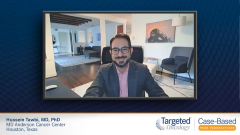
First-line Therapy Options for Patients with BRAF-mutated Metastatic Melanoma
Subject matter expert provides a comprehensive overview of available first-line therapy options for patients with unresectable or metastatic melanoma and a BRAF mutation.
Episodes in this series

Hussein Tawbi, MD, PhD: Let us go ahead and review the currently available options for patients with B-RAF mutated metastatic melanoma in the first line treatment naïve setting. We've had in hand since 2011 immunotherapy with checkpoint inhibitors and targeted therapy. From an immunotherapy perspective, we have single agent PD-1 antibodies both Nivolumab and Pembrolizumab as single agents who have shown excellent response rates in the order of 35% or more. And excellent PFS usually about six months of PFS and durable responses that we now know at five and six and seven years of about 40, 42% of patients will have an overall survival benefit. We also know that with the monotherapy of Pembrolizumab and Nivolumab, we do experience about a 15% grade three for adverse events. All of the adverse events are immune mediated. We also have two different combination immune checkpoint therapies that are available. The one that we have the longest history with is the combination of Ipilimumab and Nivolumab. With Ipilimumab being the anti CTLA-4 antibody, that was first FDA approved as a single agent in 2011. The combination is highly effective. It gives us response rates of about 55%. It gives a median PFS of about 11 months. Again, at the seven-year update from Checkmate 067 had a median overall survival of about 72 months. Excellent again options for our patients. The combination of Ipilimumab and Nivolumab is usually highly effective in specific subpopulations as well, which we'll discuss a little bit later. Like patients with brain metastases, high LDH levels, patients with liver metastases. Patients with B-RAF mutations seem to derive more benefits from the combination over a single agent PD-1. We also have a new combination in hand that's been FDA approved now since March of 2022. That's the combination of Nivolumab and the anti-LAG-3 antibody Relatlimab. That combination also known as Opdualag which is actually the generic name as well for the combination is also highly effective. It has shown to be better than single agent PD-1 in a head-to-head phase three trial, RELATIVITY-047. It showed improvement in progression-free survival with a hazard ratio of 0.78. A 22% decrease in the risk of progression or death over single agent PD-1. Response rates are around 43% compared to 32% for the single agent Nivolumab. The overall survival is still relatively early. The hazard ratio is 0.8, indicating a decrease by 20%, but was not statistically significant. The combination of Ipilimumab and Nivolumab to go back to that had a grade three for adverse events of about 59%. Whereas with Nivolumab and Relatlimab, we see a grade three for adverse events rate of only 21%. Again, the quality and the kind of incidence of the toxicity in terms of being immune related, is all immune-based. We don't see any kind of off target toxicities with these agents. But again, the quality and the pattern of the toxicity with Nivolumab and Relatlimab is more consistent with that of the single agent anti PD-1. Now, if you have a B-RAF mutation, immunotherapy is not the only option available. We have targeted therapy with B-RAF and MEK inhibitors. To be clear, we do not use single-agent B-RAF inhibitor almost ever, because we have evidence that the combination with a MEK inhibitor is more effective and actually better tolerated. If the patient has a B-RAF V600 mutation, we can treat them with one of three different combinations. B-RAF inhibitors and MEK inhibitors together. It's either Vemurafenib and Cobimetinib, Dabrafenib and Trametinib, Encorafenib and Binimetinib. The mechanism of action for all three are very, very similar. Again, the B-RAF inhibitor target the activated B-RAF mutated protein. The MEK inhibitors target the downstream of B-RAF. The three combinations are quite similar in efficacy. They give a median PFS of about 10, 11 months with Dabrafenib, Trametinib and Vemurafenib, Cobimetinib. The combination has a numerically longer PFS of 14.9 months, but it was a separate different study done at a different era. I don't consider that to be evidence of any improved efficacy. All of them give about the same response rates of about 65 to 70%. Again, all of them have a shorter duration of response than immunotherapy. Again, you heard the median PFS is in the order of about a year. In terms of toxicity, the three combinations differ significantly in terms of toxicity. Dabrafenib and Trametinib is known to cause a lot of fevers. That's kind of the most relevant toxicity. That's what we deal with the most commonly. It's usually easy to manage, which we can discuss later. Typically with the dose interruptions or dose reductions. Vemurafenib, Cobimetinib is a combination where the toxicity it can cause some fevers, but really skin toxicity is more relevant and we see a lot of photosensitivity. Also some significant rashes. Encorafenib and Binimetinib is a combination that has kind of low level of toxicities across the board, but still has all of the different types. Meaning you can still get skin toxicity, you can still get fevers. We also see some GI toxicity with this combination with both some LFT elevation and actually also diarrhea is one of the side effects. Generally speaking, again, relatively similar efficacy. Different profiles of toxicity, which tends to be the kind of the determinant of which combination we use. When it comes to the first line setting, that is the compendium of what we currently have. Again, to briefly recap, single agent anti PD-1 antibody. The combination of Ipilimumab and Nivolumab, the combination of Nivolumab and Relatlimab or one of the three B-RAF and MEK inhibitor combinations.





































